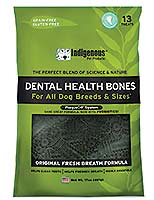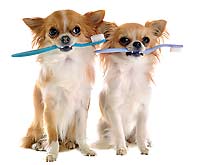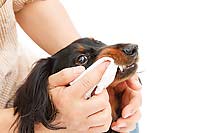We frequently hear from customers that their dog needs to eat dry food because, chewing it, cleans their teeth. Imagine going to a dentist and being told to forget about using your toothbrush because all you need for good dental health is to simply eat a few crunchy tortilla chips each day, and like magic your teeth will be clean.
Sound absurd? Well that is what most of us have been told about the nearly magical tooth-cleaning power of dry dog food. Eating kibble does not keep your pet’s teeth clean and although dry food does have nutritional benefits, relying on kibble alone to keep your dog’s teeth clean is not a good plan for dental and overall health.
When dogs eat food, a soft layer of debris coats their teeth. After 7-10 days that soft material hardens and eventually becomes a calcified food material known as tartar. As this process continues, more layers continue to build up creating a dirty mouth. Bacterial waste products in a dirty mouth are continually swallowed and can cause digestive problems. When gums swell and bleed, this creates an opening into the bloodstream, sending swarms of bacteria to the heart, liver, kidneys and other parts of the body. Many serious health problems can start with tartar buildup, which is why prevention is essential.
Dry food has much higher starch content than other types of dog foods. Since there is no type of abrasive in kibble such as bones, it gets trapped between teeth and promotes the formation of tartar. Kibble is still a good food to incorporate into your dog’s diet but it is also important to include other foods such as a raw diet and bones. Raw diets help control tartar. Raw ground bone is a gentle dental abrasive, acting like fine sandpaper when chewed, which helps remove debris stuck on teeth. The meat contains natural enzymes, and in addition, raw food doesn’t stick to teeth, unlike starchy kibble.
Chewing also plays an important role in removing plaque and tartar from your dog’s teeth. Even though there are many toys and treat products on the market that can be of some help, raw bones are really the best option, and few dogs will turn them down.
It’s important the bones are raw, because cooked bones can splinter and do serious damage to your pet’s GI tract. The size depends on the size of your pet and whether they are such an eager chewer that they risk injuring themselves or even breaking teeth. Your dog should always be supervised when they are working on a bone to minimize the risk of choking or tooth damage, and raw bones should be refrigerated between chewing sessions.
Certain dogs are predisposed to excessive tartar buildup. Some raw fed pets that also chew raw bones still accumulate tartar on their teeth. Brachycephalic (short-nosed) and toy breeds are often predisposed because their teeth do not have normal alignment, and in the case of tiny dogs, there is a crowding problem. No matter how vigorously these dog’s chew; it does not remove all of the plaque and tartar from their teeth. Dogs with chronic health problems also seem to collect more tartar on their teeth. This could be due to less vigorous chewing, or it could be the result of changes in saliva quantity, gum health, the pH in the mouth, or other causes.
Tooth brushing is the best way to insure your dog’s oral health. With a gentle hand, patience and persistence, most dog owners can teach their dog to submit to tooth brushing, which is the ideal way to insure tartar does not form on your dog’s teeth.
One of the secrets to successful tooth brushing is to progress slowly and gently, allowing your dog to adapt at their own pace. Start with your finger rather than a toothbrush and get your dog familiar with having your finger in their mouth. Gently rub the top front teeth and all the way to the back teeth, then do the same on the lower teeth. Praise your dog often and keep the sessions short.
Once your dog is accepting of the presence of your finger in their mouth, wrap a very thin damp cloth of piece of gauze around your fingertip and rub the teeth. You will probably be stunned by the amount of gunk you wipe off with just a piece of gauze. The next step is to use a safe, natural dental cleaning product designed for pets, at the Moab Barkery we carry enzymatic toothpaste from Tropiclean and Virbac.
You can also make your own homemade natural toothpaste for your dog using ingredients you probably already have at home. This recipe comes from holistic and integrative veterinarian Dr. Karen Becker; it is also the toothpaste that I use on my own dogs. The recipe requires the following ingredients to be combined and can be stored in a glass jar to be used daily or at least multiple times a week by applying a small amount to gauze before your rub your dog’s teeth…
• 2 tablespoons of baking soda (organic and aluminum-free)
• 2 tablespoons of coconut oil in liquid form (organic and unrefined)
• 1 drop peppermint oil (for fresh breath)
• 10 drops colloidal silver (optional for dog’s with gum disease)
• ½ teaspoon of turmeric powder (optional for dog’s with gum disease)
If your pet is resistant to having their teeth rubbed or brushed, there are products available that when applied to the teeth or consumed, so to work to break down plaque and tartar without brushing. Indigenous Pet Products Dental Health Bones are made with ascophyllum nodosum, natural kelp harvested from the clean, cold North Atlantic seas of Canada, Iceland and Norway. Indigenous Dental Health Bones help clean teeth and freshen breath while fighting plaque and tartar build-up. They are safe and highly digestible for all dog breeds and sizes.
If you are vigilant about your dog’s dental home care and they don’t have any special situations that predispose them to tartar build-up or other dental issues, they may never need a professional cleaning by a veterinarian. However dogs with extreme tartar build-up, badly inflamed gums, or oral infections need extra help. Digital dental x-rays can only be accomplished with sedated dogs, and tooth extractions must be done under anesthesia.
Dental procedures performed on inflamed or infected teeth and gums are extremely painful for the animal, which is why anesthesia and pain management are necessary. There are situations in which it may be entirely appropriate for a qualified technician to scale your dog’s teeth, for example if you practice good home care; you take your pet for regular veterinary wellness exams, and your dog has only a mild amount of tartar accumulation.
The bottom line is that kibble does not clean your dog’s teeth; no dog food is really capable of eliminating the need for brushing your dog’s teeth and cannot be used as a substitute for veterinary dental cleanings. After all, even humans, despite brushing our teeth religiously, we still require routine check-ups and professional cleanings, and the same things apply to our four-legged companions.
|